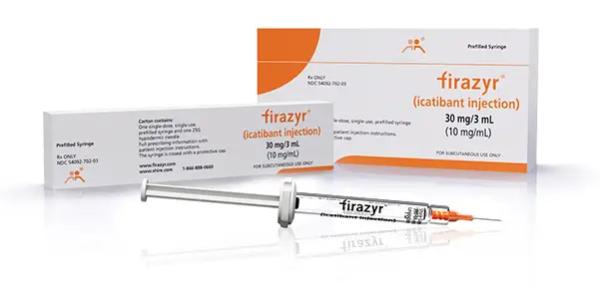Firazyr Side Effects
Generic name: icatibant
Note: This document provides detailed information about Firazyr Side Effects associated with icatibant. Some dosage forms listed on this page may not apply specifically to the brand name Firazyr.
Applies to icatibant: subcutaneous solution.
Precautions
It is very important that your doctor check your progress closely to make sure that this medicine is working properly and to decide if you should continue to receive it.
During a laryngeal (throat) HAE attack, you may have shortness of breath or troubled breathing. If you have a laryngeal HAE attack, inject this medicine and go to the nearest hospital or emergency clinic right away.
This medicine may cause severe tenderness and pain at the site of injection. Contact your doctor right away if you notice any of these side effects at the injection site: bleeding, blistering, burning, coldness, discoloration of the skin, feeling of pressure, hives, infection, inflammation, itching, lumps, numbness, pain, rash, redness, scarring, soreness, stinging, swelling, tenderness, tingling, ulceration, or warmth.
This medicine may make you dizzy, drowsy, or tired. Make sure you know how you react to this medicine before you drive, use machines, or do anything else that could be dangerous if you are dizzy or not alert.
Do not take other medicines unless they have been discussed with your doctor. This includes prescription or nonprescription (over-the-counter [OTC]) medicines and herbal or vitamin supplements.
Common side effects of Firazyr
Some side effects of icatibant may occur that usually do not need medical attention. These side effects may go away during treatment as your body adjusts to the medicine. Also, your health care professional may be able to tell you about ways to prevent or reduce some of these side effects.
Check with your health care professional if any of the following side effects continue or are bothersome or if you have any questions about them:
More common side effects
- bleeding, blistering, burning, coldness, discoloration of the skin, feeling of pressure, hives, infection, inflammation, itching, lumps, numbness, pain, rash, redness, scarring, soreness, stinging, swelling, tenderness, tingling, ulceration, or warmth at the injection site
Less common side effects
- dizziness
Serious side effects of Firazyr
Along with its needed effects, icatibant (the active ingredient contained in Firazyr) may cause some unwanted effects. Although not all of these side effects may occur, if they do occur they may need medical attention.
Check with your doctor immediately if any of the following side effects occur while taking icatibant:
Less common side effects
See also:
For healthcare professionals
Applies to icatibant: subcutaneous solution.
General adverse events
The most common adverse reactions were injection site reactions, pyrexia, transaminase increased, dizziness, and rash.[Ref]
Local
- Very common (10% or more): Injection site reaction (97%)[Ref]
Injection site reaction includes bruising, hematoma, burning, erythema, hypoesthesia, irritation, numbness, edema, pain, pressure sensation, pruritus, swelling, urticaria, or warmth at the site of injection.[Ref]
Dermatologic
- Common (1% to 10%): Rash, pruritus, erythema
- Uncommon (0.1% to 1%): Generalized urticaria[Ref]
Respiratory
- Common (1% to 10%): Nasopharyngitis, nasal congestion
- Uncommon (0.1% to 1%): Pharyngitis, asthma, cough[Ref]
Gastrointestinal
- Common (1% to 10%): Gastroenteritis, nausea
- Uncommon (0.1% to 1%): Vomiting[Ref]
Nervous system
- Common (1% to 10%): Dizziness, headache[Ref]
Other
Hepatic
- Common (1% to 10%): Transaminase increased
- Uncommon (0.1% to 1%): Liver function test abnormal[Ref]
Hematologic
- Common (1% to 10%): Prothrombin time prolonged[Ref]
Renal
- Common (1% to 10%): Blood creatinine phosphokinase increased[Ref]
Metabolic
- Uncommon (0.1% to 1%): Weight increased, blood glucose increased, hyperuricemia, hyperglycemia[Ref]
Immunologic
- Uncommon (0.1% to 1%): Herpes zoster
- Frequency not reported: Anti-icatibant (the active ingredient contained in Firazyr) antibodies[Ref]
Cardiovascular
- Uncommon (0.1% to 1%): Hot flush[Ref]
Genitourinary
- Uncommon (0.1% to 1%): Proteinuria[Ref]
Musculoskeletal
- Uncommon (0.1% to 1%): Muscle spasm[Ref]
References
1. Cerner Multum, Inc. "UK Summary of Product Characteristics."
2. Cerner Multum, Inc. "Australian Product Information."
3. (2011) "Product Information. Firazyr (icatibant)." Shire US Inc
Frequently asked questions
More about Firazyr (icatibant)
- Check interactions
- Compare alternatives
- Pricing & coupons
- Reviews (7)
- Drug images
- Dosage information
- Patient tips
- During pregnancy
- Generic availability
- FDA approval history
- Drug class: hereditary angioedema agents
- Breastfeeding
- En español
Patient resources
Professional resources
Related treatment guides
Further information
Firazyr side effects can vary depending on the individual. Always consult your healthcare provider to ensure the information displayed on this page applies to your personal circumstances.
Note: Medication side effects may be underreported. If you are experiencing side effects that are not listed, submit a report to the FDA by following this guide.

